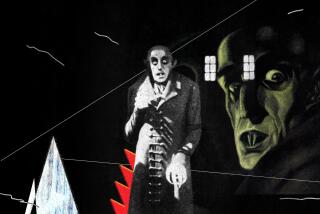ORGANIST RETURNS TO SILENT MOVIES
Contrary to current practice, silent movies were never intended to be seen in silence, says veteran theater organist Gaylord Carter.
“There always was a piano, organ or pit band to express in musical terms what was going on on the screen,” Carter, 80, said in a recent phone interview.
“People’s reactions to the (screen) images were tied together by the music, and the music added a dimension that is sorely missed when the films are shown without accompaniment.”
Carter hopes to restore that dimension when he accompanies the classic 1927 Cecil B. de Mille film “King of Kings” on the Hazel Wright organ at the Crystal Cathedral in Garden Grove at 8 p.m. Tuesday.
The San Pedro-based organist, who has accompanied the film at screenings throughout the country, uses a score that draws on music by Bach, Wagner, Saint-Saens and Respighi, among other classical composers, as well as his own compositions.
“The score is very complicated and it gets your hands and feet flying,” Carter said. “But I’ve done this picture so many times, the music is in my memory.”
De Mille’s film runs approximately two hours and relates the life of Jesus Christ seen primarily from the point of view of Mary Magdalene.
“I like the whole film,” Carter said. “But my favorite part is when Jesus mends a little girl’s doll. For that scene, I play a piece by Bernstein, the ‘Sanctus’ from his ‘Mass.’
“I always enjoy playing the music with the film. It’s a dramatic experience for me. The scene of Jesus at Gethsemane is very, very moving. Some people have told me that they come to be entertained--and stay because they have been deeply moved.”
Carter also provided accompaniment to the de Mille film in 1972 at the Garden Grove church that was the predecessor of the Crystal Cathedral. He recalled that this earlier performance was “on an organ half the size of the one we’ll be using now.”
The Hazel Wright organ has five keyboards and more than 13,000 pipes that are distributed in four locations in the building, according to Carter.
“It is a very orchestral instrument, and it has everything you need--from just a whisper to the big loud fury.
“The biggest special effect is the lightning storm after Christ has been crucified. The organ really goes. It’s not necessarily loud, but very, very solid.
“What you have to do is make the music fit the picture without intruding. You don’t play loud unless the film calls for it.”
Carter’s father was a church organist and his mother taught the piano. “I got my training by absorption when I was a child,” he said. “And I learned a lot on the job.”
His silent film accompaniment career began in 1922 at the Sunshine Theater in Los Angeles when he was 17.
He recalled: “You’d go into the theater and get thematic cue sheets from the exchange that handled the renting of the film. This would give you an idea of what the picture was--a comedy or a drama or a cowboy picture--and it would indicate a few bars for every scene.
“The first time through, I’d have to wing it, but if there was a bugle call or a steamboat whistle, at least I’d know it was coming.”
He remembers seeing “King of Kings” when it opened the new Grauman’s Chinese Theatre (now Mann’s Chinese Theatre) in Hollywood in 1927.
“Only then the film was accompanied by a symphony orchestra in the pit,” Carter said.
He accompanied silent movies until 1929, when talkies were introduced. But for a while afterward he was able to continue playing interludes between pictures and occasionally performing organ solos.
Later he moved to radio (he worked on the “Amos ‘n’ Andy” radio program when it was broadcast from the West Coast in the 1930s and later had his own “Prelude to Midnight” program on KHJ).
Eventually, he moved to television, and had his own show, “Everybody Sing with Gaylord,” on Channel 13. (He also was musical director for the Pinky Lee Show on NBC for three years.)
But recently, his career has come full circle and he finds himself regularly in demand as an accompanist for screenings of silent films.
“I’ve found a whole new career at this age,” he said. “I even have a contract with Paramount Pictures to write scores for seven of their classical (silent) films. William Wellman’s ‘Wings’ is already in the video stores.”
Other pictures he is scoring for Paramount include Joseph Von Sternberg’s “Docks of New York” and “The Last Command.”
“Right now I’m working on ‘Wedding March’ by Erich Von Stroheim, and I’m up to my ears in Viennese waltzes,” he said with a laugh.
“I’ve got a lot of zip. What I’m doing keeps you young because you have to do a lot of preparation all the time.”
More to Read
Only good movies
Get the Indie Focus newsletter, Mark Olsen's weekly guide to the world of cinema.
You may occasionally receive promotional content from the Los Angeles Times.










